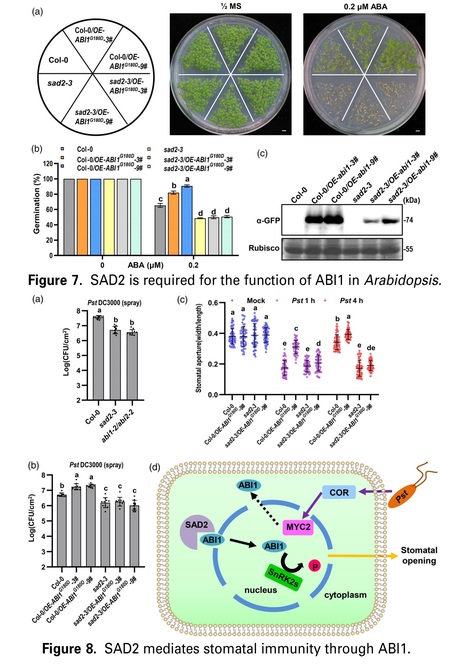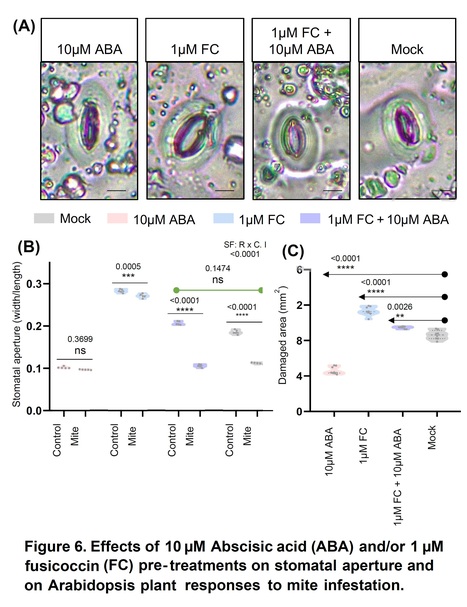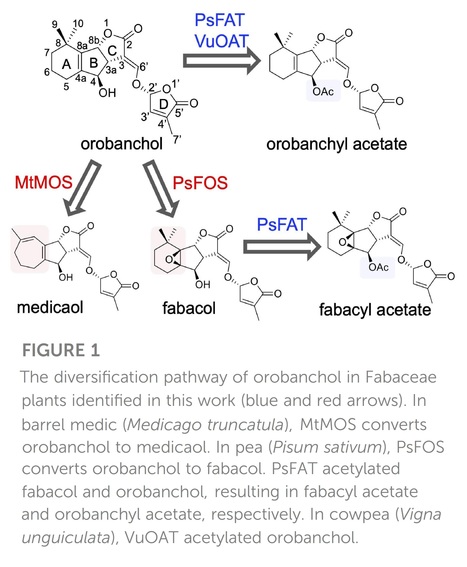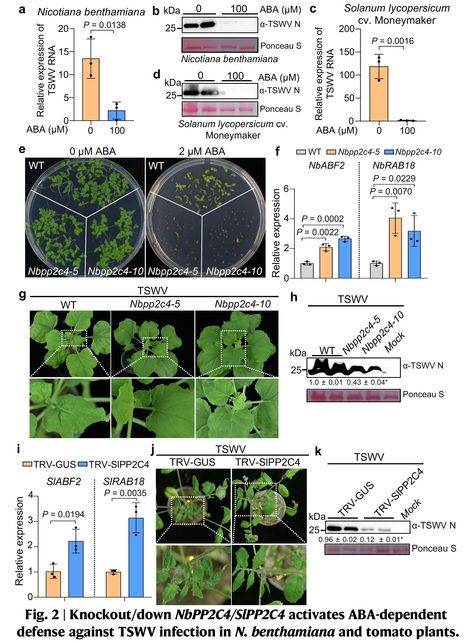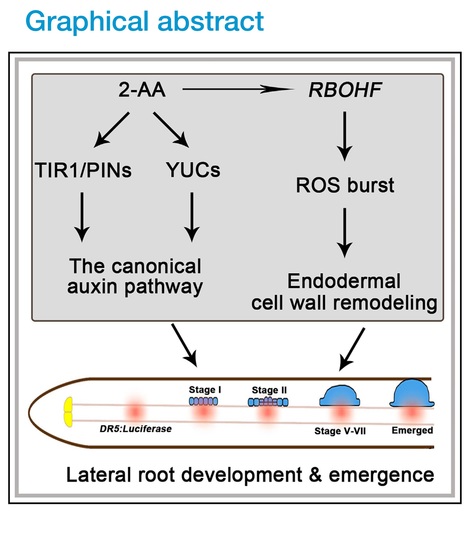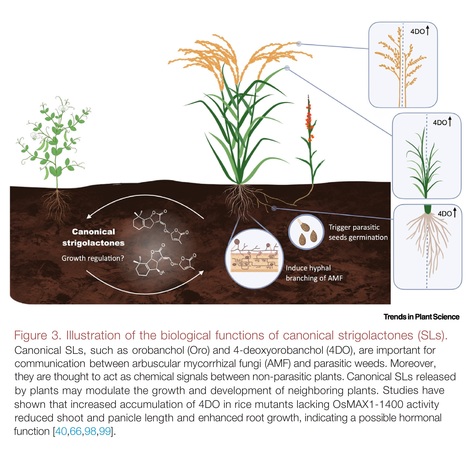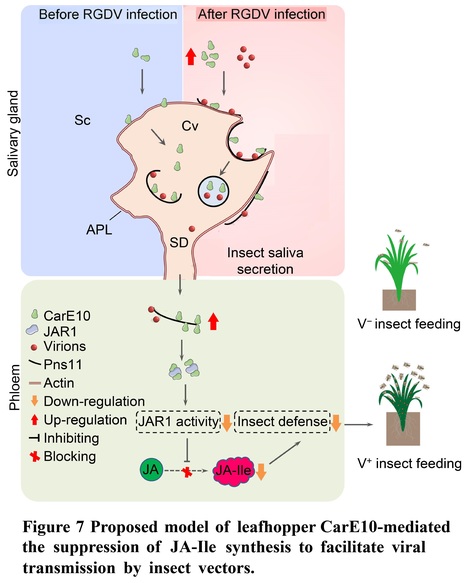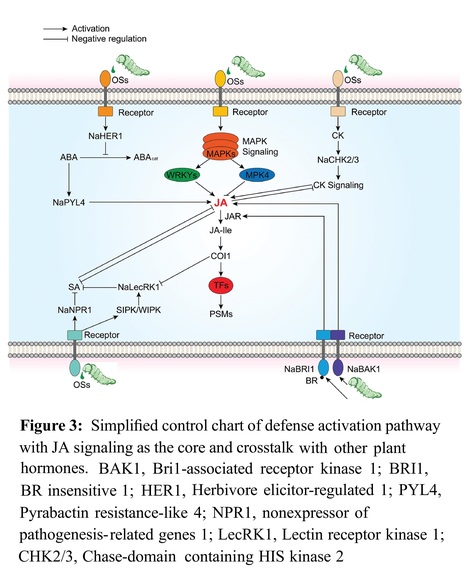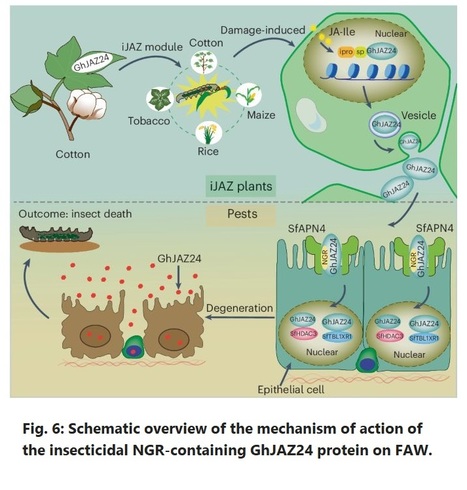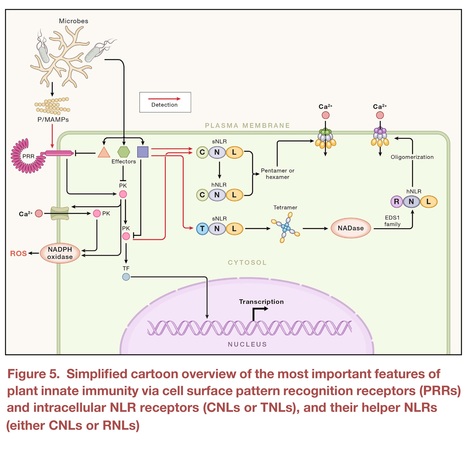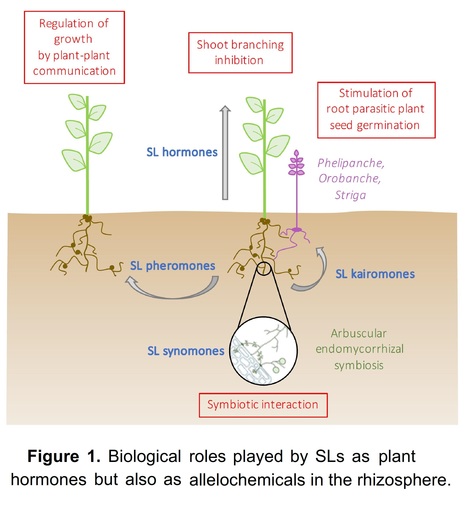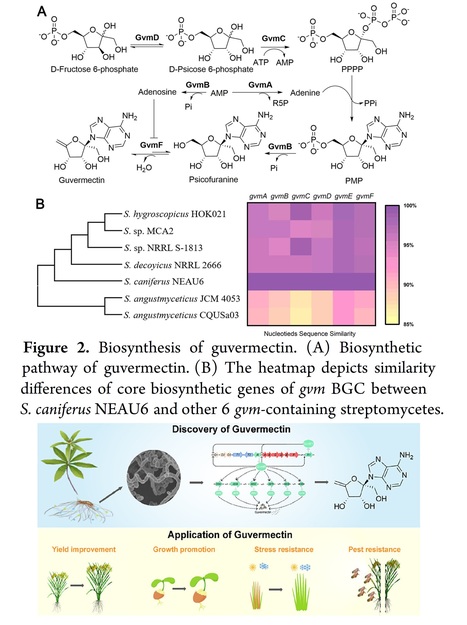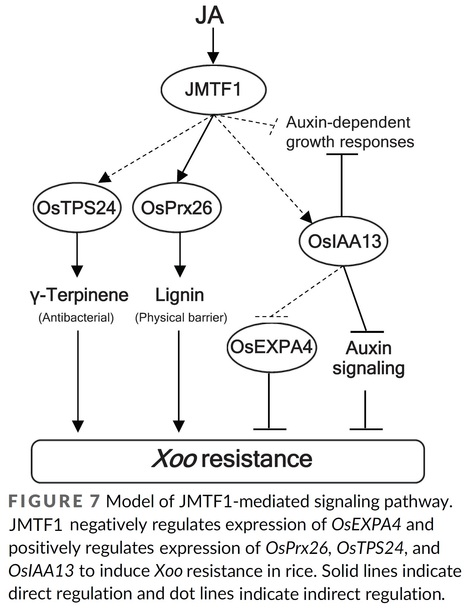 Your new post is loading...
 Your new post is loading...
Authors: Gang Wang, Xi Chen, Chengzhi Yu, Xiaobao Shi, Wenxian Lan, Chaofeng Gao, Jun Yang, Huiling Dai, Xiaowei Zhang, Huili Zhang, Boyu Zhao, Qi Xie, Nan Yu, Zuhua He, Yu Zhang and Ertao Wang.
Nature (2024)
One-sentence summary: The ubiquitin E3 ligase OsCIE1 acts as a brake to inhibit OsCERK1 during homeostasis; this brake is released after chitin stimulation.
Abstract: "Plant pattern-recognition receptors perceive microorganism-associated molecular patterns to activate immune signalling1,2. Activation of the pattern-recognition receptor kinase CERK1 is essential for immunity, but tight inhibition of receptor kinases in the absence of pathogen is crucial to prevent autoimmunity3,4. Here we find that the U-box ubiquitin E3 ligase OsCIE1 acts as a molecular brake to inhibit OsCERK1 in rice. During homeostasis, OsCIE1 ubiquitinates OsCERK1, reducing its kinase activity. In the presence of the microorganism-associated molecular pattern chitin, active OsCERK1 phosphorylates OsCIE1 and blocks its E3 ligase activity, thus releasing the brake and promoting immunity. Phosphorylation of a serine within the U-box of OsCIE1 prevents its interaction with E2 ubiquitin-conjugating enzymes and serves as a phosphorylation switch. This phosphorylation site is conserved in E3 ligases from plants to animals. Our work identifies a ligand-released brake that enables dynamic immune regulation."
Authors: Lu Liu, Yanzhi Liu, Xuehan Ji, Xia Zhao, Jun Liu and Ning Xu.
The Plant Journal (2024)
Significance Statement: Bacterial pathogens secret coronatine (COR) to recruit an importin β protein SAD2 for interfering ABA signaling in stomata and promote invasion.
Abstract: "Stomatal immunity plays an important role during bacterial pathogen invasion. Abscisic acid (ABA) induces plants to close their stomata and halt pathogen invasion, but many bacterial pathogens secrete phytotoxin coronatine (COR) to antagonize ABA signaling and reopen the stomata to promote infection at early stage of invasion. However, the underlining mechanism is not clear. SAD2 is an importin β family protein, and the sad2 mutant shows hypersensitivity to ABA. We discovered ABI1, which negatively regulated ABA signaling and reduced plant sensitivity to ABA, was accumulated in the plant nucleus after COR treatment. This event required SAD2 to import ABI1 to the plant nucleus. Abolition of SAD2 undermined ABI1 accumulation. Our study answers the long-standing question of how bacterial COR antagonizes ABA signaling and reopens plant stomata during pathogen invasion."
Authors: André Kessler and Michael B. Mueller.
Plant Signaling & Behavior (2024)
Abstract: "Plant induced responses to environmental stressors are increasingly studied in a behavioral ecology context. This is particularly true for plant induced responses to herbivory that mediate direct and indirect defenses, and tolerance. These seemingly adaptive alterations of plant defense phenotypes in the context of other environmental conditions have led to the discussion of such responses as intelligent behavior. Here we consider the concept of plant intelligence and some of its predictions for chemical information transfer in plant interaction with other organisms. Within this framework, the flow, perception, integration, and storage of environmental information are considered tunable dials that allow plants to respond adaptively to attacking herbivores while integrating past experiences and environmental cues that are predictive of future conditions. The predictive value of environmental information and the costs of acting on false information are important drivers of the evolution of plant responses to herbivory. We identify integrative priming of defense responses as a mechanism that allows plants to mitigate potential costs associated with acting on false information. The priming mechanisms provide short- and long-term memory that facilitates the integration of environmental cues without imposing significant costs. Finally, we discuss the ecological and evolutionary prediction of the plant intelligence hypothesis."
Authors: Irene Rosa-Díaz, James Rowe, Ana Cayuela-Lopez, Vicent Arbona, Isabel Díaz and Alexander M. Jones.
Plant Physiology (2024)
One-sentence summary: Arabidopsis thaliana employs abscisic acid–induced stomatal closure as an effective defense mechanism against Tetranychus urticae infestation.
Abstract: "Arthropod herbivory poses a serious threat to crop yield, prompting plants to employ intricate defense mechanisms against pest feeding. The generalist pest two-spotted spider mite (Tetranychus urticae) inflicts rapid damage and remains challenging due to its broad target range. In this study, we explored the Arabidopsis (Arabidopsis thaliana) response to T. urticae infestation, revealing the induction of abscisic acid (ABA), a hormone typically associated with abiotic stress adaptation, and stomatal closure during water stress. Leveraging a FRET-based ABA biosensor (nlsABACUS2-400n), we observed elevated ABA levels in various leaf cell types post-mite feeding. While ABA's role in pest resistance or susceptibility has been debated, an ABA-deficient mutant exhibited increased mite infestation alongside intact canonical biotic stress signaling, indicating an independent function of ABA in mite defense. We established that ABA-triggered stomatal closure effectively hinders mite feeding and minimizes leaf cell damage through genetic and pharmacological interventions targeting ABA levels, ABA signaling, stomatal aperture, and density. This study underscores the critical interplay between biotic and abiotic stresses in plants, highlighting how the vulnerability to mite infestation arising from open stomata, crucial for transpiration and photosynthesis, reinforces the intricate relationship between these stress types."
Authors: Xiaolin Cai, Wenyao Zhang, Jinnan Luo, Wei Li, Rui-hong Chen, Xiang-nan Xu, Ying-qiang Wen, Jia-yue Feng.
bioRxiv (2024)
Abstract: "Xanthomonas fragariae (Xaf) is the cause for strawberry crown dry cavity rot and strawberry leaf angular spots. Despite having a long evolutionary history with strawberries, the plant-pathogen connection is poorly understood. Pathogenicity for the majority of plant pathogens is mostly dependent on the type-III secretion system, which introduces virulence type III effectors (T3Es) into eukaryotic hosts cells. For most of these T3Es, the subcellular targets are yet unclear. Here, we used the yeast-two-hybrid (Y2H) technique to construct an interaction network of strawberry-Xaf T3Es. Multiple T3Es were discovered to converge onto the strawberry 1-aminocyclopropane-1-carboxylic acid oxidases (ACOs), which are the last rate-limited step in the production of ethylene. We then concentrated on the connection between XopL and FveACO9. Strawberry plants that overexpressed XopL accumulated higher levels of ethylene and exhibited more severe Xaf infection. XopL boosted ethylene production by stabilizing the accumulation of FveACO9 protein and enhancing ACO enzyme activity. Additionally, strawberries treated with ACC or overexpressing FveACO9 were particularly vulnerable to Xaf infection. On the other hand, pre-treatment with α-aminoinoisobutyric acid (AIB), an ACO inhibitor, effectively reduced Xaf infection. Our research indicates that Xaf utilizes a distinct approach to regulate the ethylene production of host plants in order to promote infection."
Authors: Masato Homma, Kiyono Uchida, Takatoshi Wakabayashi, Masaharu Mizutani, Hirosato Takikawa and Yukihiro Sugimoto.
Frontiers in Plant Science (2024)
Abstract: "Strigolactones (SLs), a class of plant apocarotenoids, serve dual roles as rhizosphere-signaling molecules and plant hormones. Orobanchol, a major naturally occurring SL, along with its various derivatives, has been detected in the root exudates of plants of the Fabaceae family. Medicaol, fabacyl acetate, and orobanchyl acetate were identified in the root exudates of barrel medic (Medicago truncatula), pea (Pisum sativum), and cowpea (Vigna unguiculata), respectively. Although the biosynthetic pathway leading to orobanchol production has been elucidated, the biosynthetic pathways of the orobanchol derivatives have not yet been fully elucidated. Here, we report the identification of 2-oxoglutarate-dependent dioxygenases (DOXs) and BAHD acyltransferases responsible for converting orobanchol to these derivatives in Fabaceae plants. First, the metabolic pathways downstream of orobanchol were analyzed using substrate feeding experiments. Prohexadione, an inhibitor of DOX inhibits the conversion of orobanchol to medicaol in barrel medic. The DOX inhibitor also reduced the formation of fabacyl acetate and fabacol, a precursor of fabacyl acetate, in pea. Subsequently, we utilized a dataset based on comparative transcriptome analysis to select a candidate gene encoding DOX for medicaol synthase in barrel medic. Recombinant proteins of the gene converted orobanchol to medicaol. The candidate genes encoding DOX and BAHD acyltransferase for fabacol synthase and fabacol acetyltransferase, respectively, were selected by co-expression analysis in pea. The recombinant proteins of the candidate genes converted orobanchol to fabacol and acetylated fabacol. Furthermore, fabacol acetyltransferase and its homolog in cowpea acetylated orobanchol. The kinetics and substrate specificity analyses revealed high affinity and strict recognition of the substrates of the identified enzymes. These findings shed light on the molecular mechanisms underlying the structural diversity of SLs."
Authors: Emilio Guerrieri and Sergio Rasmann.
Science (2024)
One-sentence summary: Root exudation could be harnessed for ecological and applied research.
Editor's view: Plants send and detect chemical signals aboveground that can indicate threats and resource availability, thereby facilitating coordinated responses. Plants can also communicate belowground. Through root exudates, plants can directly interact with their neighbors, or they can communicate through fungal networks and possibly through bacteria. In a Perspective, Guerrieri and Rasmann discuss what is known about the types of belowground plant communication and what effects they can elicit, such as activating diverse plant defenses and inhibiting the growth of competitive plants. The authors suggest that better understanding of these networks and the molecules that mediate communication could lead to improved methods of crop protection against pests and diseases and clarify how communities are structured, which could improve ecosystem management.
Excerpts: "Recent studies show that plants can communicate through the soil matrix. Between conspecifics, plant communication can be an efficient strategy to rapidly react to any kind of abiotic or biotic stress within a population (2). Conversely, communication between heterospecifics may regulate either competition or coexistence. Hence, understanding this communication could help reveal how plant communities are structured and how ecosystem processes are regulated (3). Belowground plant communication could thus mediate key ecological interactions in wild and agricultural systems. Belowground plant communication mainly relies on chemical signaling through root exudates. Root exudates consist of a diverse array of organic compounds, including secondary metabolites and signaling molecules, which are released by plants into the rhizosphere, the zone influenced chemically, biologically, and physically by root growth and activity (4)."
"For plant defenses against herbivores, the neurotransmitter L-DOPA is released by broad bean (Vicia faba) roots when attacked by the pea aphid Acyrtosiphon pisum, which can alert conspecific neighbors of a potential imminent herbivore attack. When alerted, the neighboring plants produce volatile organic compounds to increase their attractiveness toward an aphid parasitoid (6). Similarly, the carotenoid (–)-loliolide mediates both defensive and reproductive responses in wild-type Arabidopsis thaliana plants (7) (see the figure). Of the myriad molecules that roots can release into the soil, only a few have been characterized and found to engage in plant-to-plant communication."
Authors: Shen Huang, Chunli Wang, Zixuan Ding, Yaqian Zhao, Jing Dai, Jia Li, Haining Huang, Tongkai Wang, Min Zhu, Mingfeng Feng, Yinghua Ji, Zhongkai Zhang and Xiaorong Tao.
Nature Communications (2024)
Editor's view: Huang et al. show how plant Sw-5b NLR mimics the ABA receptor to activate ABA-dependent antiviral immunity via the PP2C-SnRK2 complex. They reveal that Sw-5b NLR induces ABA accumulation, upregulates ABA response genes, and triggers defense against viral infections by releasing SnRK2 from PP2C inhibition.
Abstract: "Defence against pathogens relies on intracellular nucleotide-binding, leucine-rich repeat immune receptors (NLRs) in plants. Hormone signaling including abscisic acid (ABA) pathways are activated by NLRs and play pivotal roles in defence against different pathogens. However, little is known about how hormone signaling pathways are activated by plant immune receptors. Here, we report that a plant NLR Sw-5b mimics the behavior of the ABA receptor and directly employs the ABA central regulator PP2C-SnRK2 complex to activate an ABA-dependent defence against viral pathogens. PP2C4 interacts with and constitutively inhibits SnRK2.3/2.4. Behaving in a similar manner as the ABA receptor, pathogen effector ligand recognition triggers the conformational change of Sw-5b NLR that enables binding to PP2C4 via the NB domain. This receptor-PP2C4 binding interferes with the interaction between PP2C4 and SnRK2.3/2.4, thereby releasing SnRK2.3/2.4 from PP2C4 inhibition to activate an ABA-specific antiviral immunity. These findings provide important insights into the activation of hormone signaling pathways by plant immune receptors."
Authors: Lin Du, Xingjia Li, Yimin Ding, Dengke Ma, Chunxin Yu and Liusheng Duan.
Journal of Agricultural and Food Chemistry (2024)
Abstract: "The pernicious parasitism exhibited by root parasitic weeds such as Orobanche and Striga poses substantial peril to agricultural productivity and global food security. This deleterious phenomenon hinges upon the targeted induction of the signaling molecule strigolactones (SLs). Consequently, the identification of prospective SL antagonists holds significant promise in the realm of mitigating the infection of these pernicious weeds. In this study, we synthesized and characterized D12 based on a potent SL antagonist KK094. In vivo assay results demonstrated that D12 remarkably impedes the germination of Phelipanche aegyptiaca and Striga asiatica seeds, while also alleviating the inhibitory consequence of the SL analogue GR24 on hypocotyl elongation in Arabidopsis thaliana. The docking study and ITC assay indicated that D12 can interact strongly with the SL receptor protein, which may interfere with the binding of SL to the receptor protein as a result. In addition, the results of crop safety assessment tests showed that D12 had no adverse effects on rice seed germination and seedling growth and development. The outcomes obtained from the present study suggested that D12 exhibited promise as a prospective antagonist of SL receptors, thereby displaying substantial efficacy in impeding the seed germination process of root parasitic weeds, providing a promising basis for rational design and development of further Striga-specific herbicides."
Authors: Chia-Yun Lee, Christopher P. Harper, Soon Goo Lee, Yunci Qi, Taylor Clay, Yuki Aoi, Joseph M. Jez, Hiroyuki Kasahara, Joshua A. V. Blodgett and Barbara N. Kunkel.
bioRxiv (2024)
Abstract: "Several plant-associated microbes synthesize the auxinic plant growth regulator phenylacetic acid (PAA) in culture; however, the role of PAA in plant-pathogen interactions is not well understood. In this study, we investigate the role of PAA during interactions between the phytopathogenic bacterium Pseudomonas syringae strain PtoDC3000 (PtoDC3000) and the model plant host, Arabidopsis thaliana. Previous work demonstrated that indole-3-acetaldehyde dehydrogenase A (AldA) of PtoDC3000 converts indole-3-acetaldehyde (IAAld) to the auxin indole-3-acetic acid (IAA). Here, we further demonstrate the biochemical versatility of AldA, as it can use both IAAld and phenylacetaldehyde as substrates to produce IAA and PAA, respectively. We also show that during infection AldA-dependent synthesis of either IAA or PAA by PtoDC3000 does not contribute significantly to the increase in auxin levels in A. thaliana leaves. Using available arogenate dehydratase (adt) mutant lines of A. thaliana compromised for PAA synthesis, we observed that a reduction in PAA-Asp and PAA-Glu is correlated with elevated levels of IAA and increased susceptibility. These results provide evidence that PAA/IAA homeostasis in A. thaliana influences the outcome of plant-microbial interactions."
Authors: Yu Chen, Yansong Fu, Yanwei Xia, Youzhi Miao, Jiahui Shao, Wei Xuan, Yunpeng Liu, Weibing Xun, Qiuyan Yan, Qirong Shen and Ruifu Zhang.
Cell Reports (2023)
Editor's view: Chen et al. show that 2-AA, a compound identified from T. guizhouense NJAU4742, promotes plant lateral root development via the canonical auxin pathway as a stimulator and increases ROS deposition in the Casparian strip as an IAA mimic, which finally enhances endodermal cell wall remodeling and facilitates lateral root emergence.
Highlights: • 2-AA identified from T. guizhouense NJAU4742 can promote lateral root development • 2-AA regulates auxin signaling and transport in the canonical auxin pathway • 2-AA enhances endodermal cell wall remodeling via an RBOHF-induced ROS burst
Abstract: "Trichoderma spp. have evolved the capacity to communicate with plants by producing various secondary metabolites (SMs). Nonhormonal SMs play important roles in plant root development, while specific SMs from rhizosphere microbes and their underlying mechanisms to control plant root branching are still largely unknown. In this study, a compound, anthranilic acid (2-AA), is identified from T. guizhouense NJAU4742 to promote lateral root development. Further studies demonstrate that 2-AA positively regulates auxin signaling and transport in the canonical auxin pathway. 2-AA also partly rescues the lateral root numbers of CASP1pro:shy2-2, which regulates endodermal cell wall remodeling via an RBOHF-induced reactive oxygen species burst. In addition, our work reports another role for microbial 2-AA in the regulation of lateral root development, which is different from its better-known role in plant indole-3-acetic acid biosynthesis. In summary, this study identifies 2-AA from T. guizhouense NJAU4742, which plays versatile roles in regulating plant root development."
Authors: Jian You Wang, Guan-Ting Erica Chen, Justine Braguy and Salim Al-Babili.
Trends in Plant Science (2024)
Highlights: Strigolactones (SLs) are structurally diverse and divided into canonical and non-canonical subgroups. SLs are generally considered as plant hormones, best known for inhibiting shoot branching/tillering. SLs are rhizospheric signals important for arbuscular mycorrhizal symbiosis, which may be their ancestral function that is conserved from liverworts to flowering plants. Recent results have revealed functional specificity, indicating that canonical SLs are not the tillering/branching inhibitory hormone in rice or tomato. Increasing the content of 4-deoxyorobanchol in rice by interrupting its hydroxylation affects root, shoot, and panicle growth, suggesting that this canonical SL has hormonal functions. Reducing the levels of canonical SLs by genome editing or applying specific inhibitors is a promising strategy for reducing Striga parasitism.
Abstract: "Strigolactones (SLs) act as regulators of plant architecture as well as signals in rhizospheric communications. Reduced availability of minerals, particularly phosphorus, leads to an increase in the formation and release of SLs that enable adaptation of root and shoot architecture to nutrient limitation and, simultaneously, attract arbuscular mycorrhizal fungi (AMF) for establishing beneficial symbiosis. Based on their chemical structure, SLs are designated as either canonical or non-canonical; however, the question of whether the two classes are also distinguished in their biological functions remained largely elusive until recently. In this review we summarize the latest advances in SL biosynthesis and highlight new findings pointing to rhizospheric signaling as the major function of canonical SLs."
Authors: Ruolin Wang, Beibei Li, Jiang Zhang and Ling Chang.
PLoS ONE (2024)
Abstract: "In our previous work, cytokinin (CK) signaling and biosynthesis were found to be modulated during Arabidopsis defense against infection by the necrotrophic pathogen Botrytis cinerea. Notably, the expression level of CYTOKININ OXIDASE/DEHYDROGENASE 5 (CKX5) was significantly induced in B. cinerea-infected leaves and later in distant B. cinerea-untreated leaves of the same plant. To confirm and determine how CKX5 is involved in the response to B. cinerea infection, transcript levels of CKX family genes were analyzed in B. cinerea-inoculated leaves, and only CKX5 was remarkably induced by B. cinerea infection. Furthermore, CKX5-overexpressing Arabidopsis plants were more resistant to B. cinerea than wild-type plants. Transcription factors (TFs) binding to the CKX5 promoter were then screened by yeast one-hybrid assays. Quantitative Real-Time Reverse Transcription PCR (qRT-PCR) analysis further showed that genes encoding TFs, including WRKY40, WRKY33, ERF6, AHL15, AHL17, ANAC003, TCP13 and ANAC019, were also strongly induced in infected leaves, similar to CKX5. Analysis of ERF6-overexpressing plants and ERF6-and AHL15-knockout mutants indicated that ERF6 and AHL15 are involved in plant immunity to B. cinerea. Furthermore, CKX5 upregulation by B. cinerea infection was affected when ERF6 or AHL15 levels were altered. Our work suggests that CKX5 levels are controlled by the plant defense system to defend against attack by the pathogen B. cinerea."
|
Authors: Yunhua Chi, Hongxiang Zhang, Siyu Chen, Yu Cheng, Xiaofeng Zhang, Dongsheng Jia, Qian Chen, Hongyan Chen and Taiyun Wei.
Plant Communications (2024)
Abstract: "Plant jasmonoyl-L-isoleucine (JA-Ile) is a major defense signal against insect feeding, but whether or how insect salivary effectors suppress JA-Ile synthesis and thus facilitate viral transmission in plant phloem remains elusive. Insect carboxylesterases (CarEs) are the third major family of detoxification enzymes. Here, we identify a new leafhopper CarE10 that specifically expressed in salivary glands and is secreted into rice phloem as the saliva component. Leafhopper CarE10 directly binds and promotes rice Jasmonate resistant 1 (JAR1) degradation by the proteasome system. Moreover, the direct association of CarE10 with JAR1 obviously impairs JAR1 enzyme activity for JA conversion to JA-Ile in in-vitro JA-Ile synthesis system. A devastating rice reovirus activates and promotes co-secretion of virions and CarE10 by virus-induced vesicles into saliva-stored salivary cavities of leafhopper vectors and ultimately into rice phloem to establish initial infection. Furthermore, virus-mediated increase of CarE10 secretion or overexpression of CarE10 in transgenic rice plants causes the reduced levels of JAR1 and thus suppresses JA-Ile synthesis, thereby promoting host attractiveness to insect vectors and facilitating initial viral transmission. Our findings provide insights into how insect salivary protein CarE10 suppresses host JA-Ile synthesis to benefit initial virus transmission in rice phloem."
Authors: Guangwei Sun, Xuanhao Zhang, Yi Liu, Liguang Chai, Daisong Liu, Zhenguo Chen and Shiyou Lü.
Phyton (2024)
Abstract: "The Nicotiana genus, commonly known as tobacco, holds significant importance as a crucial economic crop. Confronted with an abundance of herbivorous insects that pose a substantial threat to yield, tobacco has developed a diverse and sophisticated array of mechanisms, establishing itself as a model of plant ecological defense. This review provides a concise overview of the current understanding of tobacco’s defense strategies against herbivores. Direct defenses, exemplified by its well-known tactic of secreting the alkaloid nicotine, serve as a potent toxin against a broad spectrum of herbivorous pests. Moreover, in response to herbivore attacks, tobacco enhances the discharge of volatile compounds, harnessing an indirect strategy that attracts the predators of the herbivores. The delicate balance between defense and growth leads to the initiation of most defense strategies only after a herbivore attack. Among plant hormones, notably jasmonic acid (JA), play central roles in coordinating these defense processes. JA signaling interacts with other plant hormone signaling pathways to facilitate the extensive transcriptional and metabolic adjustments in plants following herbivore assault. By shedding light on these ecological defense strategies, this review emphasizes not only tobacco’s remarkable adaptability in its natural habitat but also offers insights beneficial for enhancing the resilience of current crops."
Authors: Huijuan Mo, Huimin Chang, Ge Zhao, Guanjing Hu, Xiumei Luo, Xue Jia, Zhenlu Xu, Guangming Ren, Li Feng, Jonathan F. Wendel, Xiaoya Chen, Maozhi Ren and Fuguang Li.
Nature Plant (2024)
Editor's view: In this study, Mo et al. describe a novel biotechnological strategy to produce crop plants resistant to lepidopteran pests.
Abstract: "The fall armyworm (FAW) poses a significant threat to global crop production. Here we showed that overexpression of jasmonate ZIM-domain (JAZ) protein GhJAZ24 confers resistance to cotton bollworm and FAW, while also causing sterility in transgenic cotton by recruiting TOPLESS and histone deacetylase 6. We identified the NGR motif of GhJAZ24 that recognizes and binds the aminopeptidase N receptor, enabling GhJAZ24 to enter cells and disrupt histone deacetylase 3, leading to cell death. To overcome plant sterility associated with GhJAZ24 overexpression, we developed iJAZ (i, induced), an approach involving damage-induced expression and a switch from intracellular to extracellular localization of GhJAZ24. iJAZ transgenic cotton maintained fertility and showed insecticidal activity against cotton bollworm and FAW. In addition, iJAZ transgenic rice, maize and tobacco plants showed insecticidal activity against their lepidopteran pests, resulting in an iJAZ-based approach for generating alternative insecticidal proteins with distinctive mechanisms of action, thus holding immense potential for future crop engineering."
Authors: Jonathan D.G. Jones, Brian J. Staskawicz and Jeffery L. Dangl.
Cell (2024)
Abstract: "Plant diseases cause famines, drive human migration, and present challenges to agricultural sustainability as pathogen ranges shift under climate change. Plant breeders discovered Mendelian genetic loci conferring disease resistance to specific pathogen isolates over 100 years ago. Subsequent breeding for disease resistance underpins modern agriculture and, along with the emergence and focus on model plants for genetics and genomics research, has provided rich resources for molecular biological exploration over the last 50 years. These studies led to the identification of extracellular and intracellular receptors that convert recognition of extracellular microbe-encoded molecular patterns or intracellular pathogen-delivered virulence effectors into defense activation. These receptor systems, and downstream responses, define plant immune systems that have evolved since the migration of plants to land ∼500 million years ago. Our current understanding of plant immune systems provides the platform for development of rational resistance enhancement to control the many diseases that continue to plague crop production."
Authors: Tingliang Xu, Xiaowen Zheng, Yi Yang, Shumin Yang, Xingwan Yi, Chao Yu, Le Luo, Jia Wang, Tangren Cheng, Qixiang Zhang and Huitang Pan.
Planta (2024)
Main conclusion: IAA cooperates with JA to inhibit SA and negatively regulates rose black spot disease resistance.
Abstract: "Black spot disease caused by the fungus Marssonina rosae is the most prevalent and severe ailment in rose cultivation, leading to the appearance of black spots on leaves and eventual leaf fall, significantly impacting the utilization of roses in gardens. Salicylic acid (SA) and jasmonic acid (JA) are pivotal hormones that collaborate with indole-3 acetic acid (IAA) in regulating plant defense responses; however, the detailed mechanisms underlying the induction of black spot disease resistance by IAA, JA, and SA remain unclear. In this study, transcript analysis was conducted on resistant (R13–54) and susceptible (R12–26) lines following M. rosae infection. In addition, the impact of exogenous interference with IAA on SA- and JA-mediated disease resistance was examined. The continuous accumulation of JA, in synergy with IAA, inhibited activation of the SA signaling pathway in the early infection stage, thereby negatively regulating the induction of effective resistance to black spot disease. IAA administration alleviated the inhibition of SA on JA to negatively regulate the resistance of susceptible strains by further enhancing the synthesis and accumulation of JA. However, IAA did not contribute to the negative regulation of black spot resistance when high levels of JA were inhibited. Virus-induced gene silencing of RcTIFY10A, an inhibitor of the JA signaling pathway, further suggested that IAA upregulation led to a decrease in disease resistance, a phenomenon not observed when the JA signal was inhibited. Collectively, these findings indicate that the IAA-mediated negative regulation of black spot disease resistance relies on activation of the JA signaling pathway."
Authors: Yordan J. Romero-Contreras, Francisco González-Serrano, Elena Bello-López, Damien Formey, Wendy Aragón, Miguel Ángel Cevallos, Eria A. Rebollar and Mario Serrano.
Plant Molecular Biology (2024)
Abstract: "Plants and microorganisms establish beneficial associations that can improve their development and growth. Recently, it has been demonstrated that bacteria isolated from the skin of amphibians can contribute to plant growth and defense. However, the molecular mechanisms involved in the beneficial effect for the host are still unclear. In this work, we explored whether bacteria isolated from three tropical frogs species can contribute to plant growth. After a wide screening, we identified three bacterial strains with high biostimulant potential, capable of modifying the root structure of Arabidopsis thaliana plants. In addition, applying individual bacterial cultures to Solanum lycopersicum plants induced an increase in their growth. To understand the effect that these microorganisms have over the host plant, we analysed the transcriptomic profile of A. thaliana during the interaction with the C32I bacterium, demonstrating that the presence of the bacteria elicits a transcriptional response associated to plant hormone biosynthesis. Our results show that amphibian skin bacteria can function as biostimulants to improve agricultural crops growth and development by modifying the plant transcriptomic responses."
Via Jean-Michel Ané
Authors: Suzanne Daignan Fornier, Antoinette Keita and François-Didier Boyer.
ChemBioChem (2024)
Abstract: "Today, the use of artificial pesticides is questionable and the adaptation to global warming is a necessity. The promotion of favorable natural interactions in the rhizosphere offers interesting perspectives for changing the type of agriculture. Strigolactones (SLs), the latest class of phytohormones to be discovered, are also chemical mediators in the rhizosphere. We present in this review the diversity of natural SLs, their analogs, mimics, and probes essential for the biological studies of this class of compounds. Their biosynthesis and access by organic synthesis are highlighted especially concerning noncanonical SLs, the more recently discovered natural SLs. Organic synthesis of analogs, stable isotope-labeled standards, mimics, and probes are also reviewed here. In the last part, the knowledge about the SL perception is described as well as the different inhibitors of SL receptors that have been developed."
Authors: Chongxi Liu, Manman Zhang, Lei Li, Xiangjing Wang, Shanshan Li and Wensheng Xiang.
Journal of Agricultural and Food Chemistry (2024)
Abstract: "Plant growth regulators (PGRs) play an important role in alleviating the detrimental effects of biotic and abiotic stress and improving crop yield and quality. As a novel PGR from Streptomyces registered in 2021, guvermectin (GV) has the potential to improve plant yield and defense, making its application in agriculture a subject of interest. Here, we describe the discovery process, functional activities, agricultural applications, toxicity, environmental safety, and biosynthetic mechanism of GV. This Perspective provides a guide for the development of novel PGRs from microorganisms."
Authors: Wenzhe Yu, Li Luo, Xiangyu Qi, Yuman Cao, Jie An, Zhiguo Xie, Tianming Hu and Peizhi Yang.
Journal of Agricultural and Food Chemistry (2024)
Abstract: "Plant growth-promoting rhizobacteria have been shown to enhance plant tolerance to drought stress through various mechanisms. However, there is limited research on improving drought resistance in alfalfa by genetically modifying PGPR to produce increased levels of cytokinins. Herein, we employed synthetic biology approaches to engineer two novel strains of Sinorhizobium meliloti capable of overproducing trans-Zeatin and investigated their potential in enhancing drought tolerance in alfalfa. Our results demonstrate that alfalfa plants inoculated with these engineered S. meliloti strains exhibited reduced wilting and yellowing while maintaining higher relative water content under drought conditions. The engineered S. meliloti-induced tZ activated the activity of antioxidant enzymes and the accumulation of osmolytes. Additionally, the increased endogenous tZ content in plants alleviated the impact of drought stress on the alfalfa photosynthetic rate. However, under nondrought conditions, inoculation with the engineered S. meliloti strains had no significant effect on alfalfa biomass and nodule formation."
Authors: Xiaofang Li, Xin Zheng, Nikita Yadav, Shouvik Saha, El-Sayed Salama, Xiangkai Li, Likun Wang and Byong-Hun Jeon.
Plant Communications (2024)
Abstract: The Green Revolution of the mid-20th century transformed agriculture worldwide and has resulted in environmental challenges. A new approach, the Second Green Revolution, seeks to enhance agricultural productivity while minimizing negative environmental impacts. Plant microbiomes play critical roles in plant growth and stress responses, and understanding plant–microbiome interactions is essential for developing sustainable agricultural practices that meet food security and safety challenges, which are among the United Nations Sustainable Development Goals. This review provides a comprehensive exploration of key deterministic processes crucial for developing microbiome management strategies, including the host effect, the facilitator effect, and microbe–microbe interactions. A hierarchical framework for plant microbiome modulation is proposed to bridge the gap between basic research and agricultural applications. This framework emphasizes three levels of modulation: single-strain, synthetic community, and in situ microbiome modulation. Overall, rational management of plant microbiomes has wide-ranging applications in agriculture and can potentially be a core technology for the Second Green Revolution."
Authors: Dacheng Wang, Lirong Wei, Jinbiao Ma, Kenichi Tsuda, Chunhao Jiang and Yiming Wang.
Cell Reports (2024)
Editor's view: The plant microbiome helps to shape the immune system to counter infection of pathogens. Wang et al. show that the root-associated Bacillus cereus NJ01 significantly enhances plant resistance. The EDS1-WRKY18 module is required for NJ01-enhanced disease resistance through activation of SA- and ABA-mediated immunity.
Highlights: • Rhizobacterium Bacillus cereus NJ01 enhances plant resistance against bacterial pathogens • EDS1 enhances WRKY18 DNA-binding activity for the NJ01-enhanced disease resistance • ICS1 and NCED3/5 are downstream of EDS1-WRKY18 for NJ01-enhanced disease resistance
Abstract: "Emerging evidence suggests a beneficial role of rhizobacteria in ameliorating plant disease resistance in an environment-friendly way. In this study, we characterize a rhizobacterium, Bacillus cereus NJ01, that enhances bacterial pathogen resistance in rice and Arabidopsis. Transcriptome analyses show that root inoculation of NJ01 induces the expression of salicylic acid (SA)- and abscisic acid (ABA)-related genes in Arabidopsis leaves. Genetic evidence showed that EDS1, PAD4, and WRKY18 are required for B. cereus NJ01-induced bacterial resistance. An EDS1-PAD4 complex interacts with WRKY18 and enhances its DNA binding activity. WRKY18 directly binds to the W box in the promoter region of the SA biosynthesis gene ICS1 and ABA biosynthesis genes NCED3 and NCED5 and contributes to the NJ01-induced bacterial resistance. Taken together, our findings indicate a role of the EDS1/PAD4-WRKY18 complex in rhizobacteria-induced disease resistance."
Authors: Yuya Uji, Go Suzuki, Yumi Fujii, Keita Kashihara, Shoko Yamada and Kenji Gomi.
Physiologia Plantarum (2024)
Abstract: "The plant hormone jasmonic acid (JA) is a signalling compound involved in the regulation of cellular defence and development in plants. In this study, we investigated the roles of a JA-responsive MYB transcription factor, JMTF1, in the JA-regulated defence response against rice bacterial blight caused by Xanthomonas oryzae pv. oryzae (Xoo). JMTF1 did not interact with any JASMONATE ZIM-domain (JAZ) proteins. Transgenic rice plants overexpressing JMTF1 showed a JA-hypersensitive phenotype and enhanced resistance against Xoo. JMTF1 upregulated the expression of a peroxidase, OsPrx26, and monoterpene synthase, OsTPS24, which are involved in the biosynthesis of lignin and antibacterial monoterpene, γ-terpinene, respectively. OsPrx26 was mainly expressed in the vascular bundle. Transgenic rice plants overexpressing OsPrx26 showed enhanced resistance against Xoo. In addition to the JA-hypersensitive phenotype, the JMTF1-overexpressing rice plants showed a typical auxin-related phenotype. The leaf divergence and shoot gravitropic responses were defective, and the number of lateral roots decreased significantly in the JMTF1-overexpressing rice plants. JMTF1 downregulated the expression of auxin-responsive genes but upregulated the expression of OsIAA13, a suppressor of auxin signalling. The rice gain-of-function mutant Osiaa13 showed high resistance against Xoo. Transgenic rice plants overexpressing OsEXPA4, a JMTF1-downregulated auxin-responsive gene, showed increased susceptibility to Xoo. JMTF1 is selectively bound to the promoter of OsPrx26 in vivo. These results suggest that JMTF1 positively regulates disease resistance against Xoo by coordinating crosstalk between JA- and auxin-signalling in rice."
|



 Your new post is loading...
Your new post is loading...


